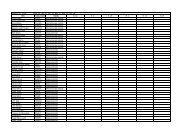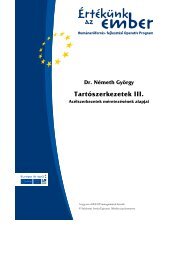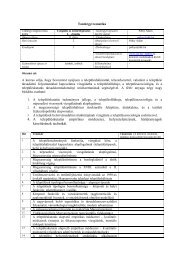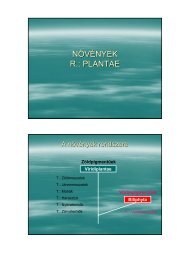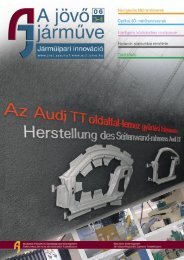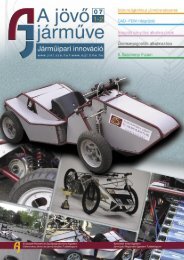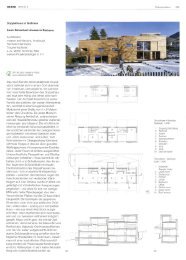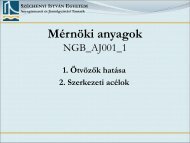Environmental Kuznets curves—real progress or passing the buck ...
Environmental Kuznets curves—real progress or passing the buck ...
Environmental Kuznets curves—real progress or passing the buck ...
You also want an ePaper? Increase the reach of your titles
YUMPU automatically turns print PDFs into web optimized ePapers that Google loves.
184<br />
D.S. Rothman / Ecological Economics 25 (1998) 177–194<br />
Table 1<br />
Quadratic fits to consumption data<br />
Commodity<br />
Fitted equation a Adjusted r 2<br />
Turning point b<br />
Food, beverages, and 79.36 (1.7)+0.21 (10.8)×(GDP/capita)−7.98×10 −6 (6.1)<br />
tobacco<br />
(GDP/capita) 2<br />
Clothing and footwear 58.41 (2.6)+0.04 (4.4)×(GDP/capita)−5.61×10 −7 (0.9) (GDP/<br />
0.8893 12 889<br />
0.7890 35 263<br />
0.8158 23 278<br />
0.9197<br />
Gross rent, fuel and power −44.62 (0.5)+0.20 (5.4)×(GDP/capita)−4.25×10 −6 (1.7)<br />
capita) 2<br />
House furnishings and 0.16 (0.0)+0.04 (5.7)×(GDP/capita)+1.79×10 −7 (0.4) (GDP/<br />
(GDP/capita) 2<br />
operations<br />
capita) 2<br />
Medical care and services −101.81 (1.6)+0.12 (4.6)×(GDP/capita)−1.30×10 −6 (0.7) 0.8270 47 171<br />
Transp<strong>or</strong>t and communicacapita)<br />
(GDP/capita) 2<br />
55.29 (1.9)+0.00 (0.1)×(GDP/capita)+4.93×10 −6 (6.1) (GDP/ 0.9236<br />
tions<br />
2<br />
Recreation, entertainment, 20.03 (0.4)+0.10 (4.5)×(GDP/capita)+1.17×10 −7 (0.1) (GDP/ 0.8684<br />
education, etc. capita) 2<br />
O<strong>the</strong>r −39.08 (0.6)+0.06 (2.2)×(GDP/capita)+2.05×10 −6 (1.1) 0.7652<br />
0.4949<br />
13 169<br />
Grains and starches 80.99 (2.7)+0.07 (5.4)×(GDP/capita)−3.44×10 −6 (4.0) (GDP/<br />
9830<br />
(GDP/capita) 2<br />
Meat and animal products 3.42 (0.2I)+0.08 (9.2)×(GDP/capita)−3.03×10 −6 (5.1) (GDP/ 0.8591<br />
capita) 2<br />
O<strong>the</strong>r foods, beverages and<br />
capita) 2<br />
14.27 (0.5)+0.06 (5.7)×(GDP/capita)−1.91×10 −6 (2.5) (GDP/ 0.7700 16 357<br />
tobacco<br />
capita) 2<br />
a Equations fitted to data provided by phase V of <strong>the</strong> United Nations International Comparison Programme (United Nations, 1994).<br />
Values in italic and paren<strong>the</strong>ses are absolute values of <strong>the</strong> t-statistics f<strong>or</strong> <strong>the</strong> coefficients.<br />
b Turning points only calculated f<strong>or</strong> equations with negative coefficients on GDP 2 .<br />
provide an initial indication whe<strong>the</strong>r <strong>the</strong>se relationships<br />
show an inverted-U type of behavi<strong>or</strong><br />
that might supp<strong>or</strong>t <strong>the</strong> EKC hypo<strong>the</strong>sis. Table 1<br />
summarizes <strong>the</strong>se relationships. Although composition,<br />
in terms of shares, does change with income,<br />
this is due principally to differences in<br />
relative growth between categ<strong>or</strong>ies and not actual<br />
declines in consumption of any single commodity.<br />
The only commodity that displays an inverted-U<br />
shape is food, beverages, and tobacco 8 . Breaking<br />
this down into three categ<strong>or</strong>ies—grains and<br />
starches, meat and animal products and o<strong>the</strong>r<br />
foods—shows that this is principally due to a<br />
decline in <strong>the</strong> consumption of grains and starches,<br />
arguably <strong>the</strong> least environmentally destructive<br />
food items (Fig. 4 and Table 1).<br />
8 The auth<strong>or</strong> defines an inverted-U shape as requiring a<br />
negative coefficient on squared GDP per capita with a t-statistic<br />
greater than 2 in absolute value and a turning point that<br />
falls within <strong>the</strong> range of <strong>the</strong> data.<br />
Adriaanse et al. (1997) have estimated <strong>the</strong> total<br />
material requirements, including hidden flows, f<strong>or</strong><br />
<strong>the</strong> economies of <strong>the</strong> United States, The Ne<strong>the</strong>rlands,<br />
Germany and Japan f<strong>or</strong> <strong>the</strong> past two<br />
decades. Their data show that, although <strong>the</strong>re has<br />
been a pattern of declining material intensity, in<br />
terms of material requirements per unit of GDP,<br />
per capita natural resource requirements have<br />
continued to rise. An imp<strong>or</strong>tant caveat in using<br />
<strong>the</strong>se data, however, is that <strong>the</strong> materials required<br />
to meet exp<strong>or</strong>t demands are not currently deducted,<br />
so <strong>the</strong> measure does not yet provide a<br />
completely balanced picture of <strong>the</strong> requirements<br />
needed to meet <strong>the</strong> consumption demands of a<br />
particular country. de Bruyn and Opscho<strong>or</strong> (1997)<br />
and Suri and Chapman (1998) are <strong>the</strong> only researchers<br />
to date who have noted <strong>the</strong> imp<strong>or</strong>tance<br />
of taking a consumption-based approach to analyzing<br />
<strong>the</strong> EKC hypo<strong>the</strong>sis. In each case, <strong>the</strong><br />
researchers find very little evidence to supp<strong>or</strong>t a





